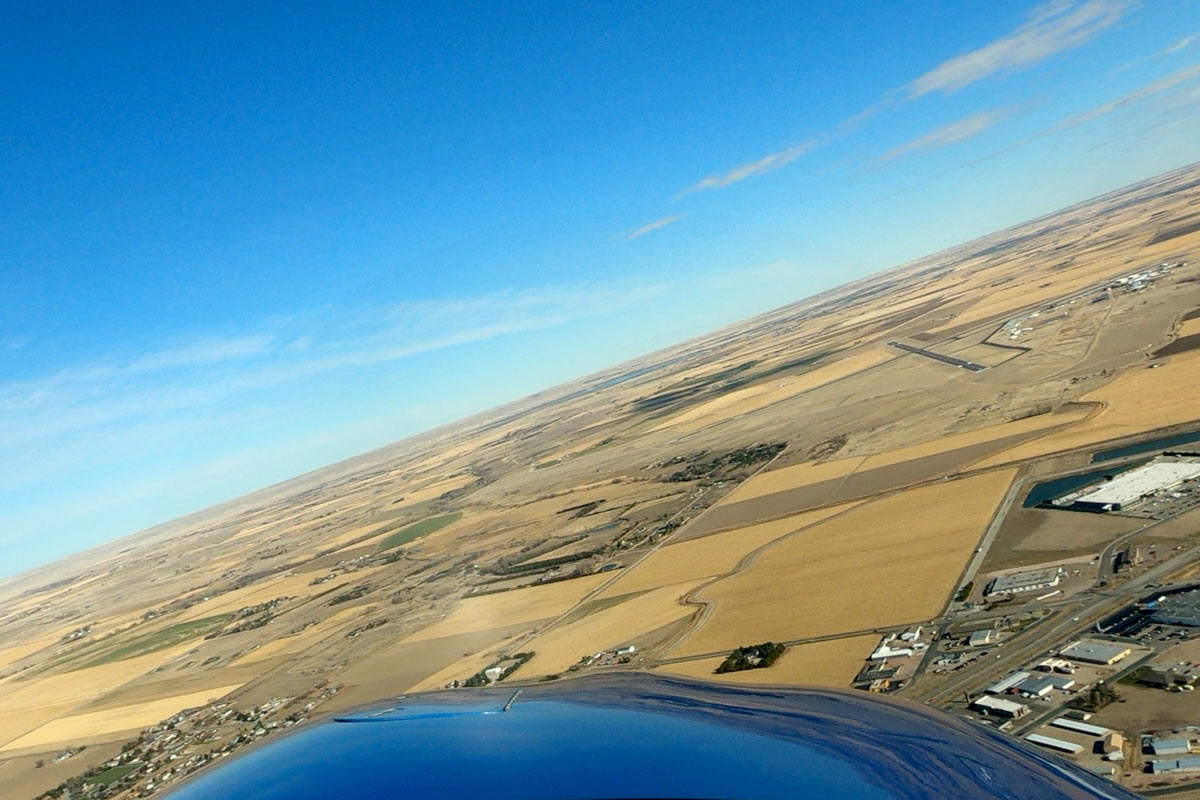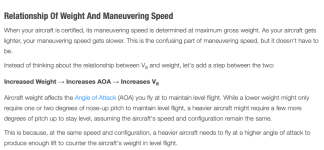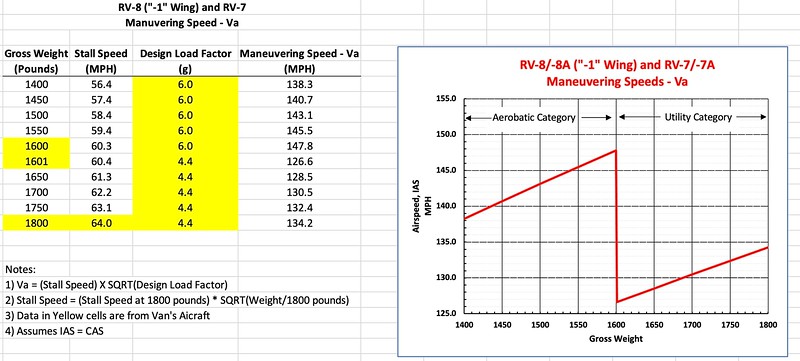Van's Air Force
You are using an out of date browser. It may not display this or other websites correctly.
You should upgrade or use an alternative browser.
You should upgrade or use an alternative browser.
RV 14 V SPEEDS
- Thread starter craig.roser
- Start date
Can this be correct:
Va 147 knots 1900 lbs
Va 130 knots 2050 lbs
Shouldn't lower weight be lower speed?
The purpose of maneuvering speed is to protect against damage in turbulence by assuring stall below max g-loading: at higher weights this speed is higher, not lower. (EDITED - ERROR IN THE ORIGINAL POST)

Why Does Maneuvering Speed Change With Weight?
Contrary to popular belief, you can't just throw your stick and rudders back and forth below Va and expect to not bend metal.
Last edited:
Turner, I'm also reading this the other way, lower weight is lower Va, so agree it seems to go against the guidance. However, the web site and other literature are generalizing, so it could be that the AOA vs weight vs max load have all been tested, and found this design does not match the generalization?The speeds are correct.
The purpose of maneuvering speed is to protect against damage in turbulence by assuring stall below max g-loading: at higher weights this speed is lower, not higher.

Why Does Maneuvering Speed Change With Weight?
Contrary to popular belief, you can't just throw your stick and rudders back and forth below Va and expect to not bend metal.www.boldmethod.com

Note that for the two different speeds listed, one is for utility category load limits and the other is aerobatic load limits.Can this be correct:
Va 147 knots 1900 lbs
Va 130 knots 2050 lbs
Shouldn't lower weight be lower speed?
Since 1900 pounds is aerobatic gross weight, the higher load limit skews the speed value in an atypical direction compared to an aircraft that had a fixed value load limit.
Ah, that makes sense, because of the category, the g limit is different. So the same rule of thumb would apply, but the difference is what g limit category you are using. An example would be utility category at 1900lbs vs 2050 lbs, the Va would be less then 130. Same with aerobatics category, at say 1500 vs 1900 lbs, Va would be less then 147. I think would would use the following to get an approximate Va for that lower weight (for either aero or utility, but they won't be the same because of the different in max gross at that category).Note that for the two different speeds listed, one is for utility category load limits and the other is aerobatic load limits.
Since 1900 pounds is aerobatic gross weight, the higher load limit skews the speed value in an atypical direction compared to an aircraft that had a fixed value load limit.

I quoted it wrong - meant to say higher weight, higher speed. Scott's correction makes sense. I had a brain cramp earlier this morning.....Turner, I'm also reading this the other way, lower weight is lower Va, so agree it seems to go against the guidance. However, the web site and other literature are generalizing, so it could be that the AOA vs weight vs max load have all been tested, and found this design does not match the generalization?
View attachment 60862
RV8JD
Well Known Member
I put together the chart shown below for the RV-8 (and it applies to the RV-7 as well). One could put one together for the RV-14.
The chart uses Van's data (shown in Yellow) for the flaps up clean stall speed at Max Gross Weight, and the Utility Category and Aerobatic Category Load Factor Limits and their associated weights. Then stall speeds and maneuvering speeds are calculated using the formulas in the 'Notes'.
If you take the change in stall speed with changing weight into account, and the Aerobatic and Utility Category Load Factor Limits into account, Flaps-Up Va looks like this:

Note: Van's states Va for the RV-8 (and RV-7) as 142 MPH IAS.
<Use this information at your risk!>
The chart uses Van's data (shown in Yellow) for the flaps up clean stall speed at Max Gross Weight, and the Utility Category and Aerobatic Category Load Factor Limits and their associated weights. Then stall speeds and maneuvering speeds are calculated using the formulas in the 'Notes'.
If you take the change in stall speed with changing weight into account, and the Aerobatic and Utility Category Load Factor Limits into account, Flaps-Up Va looks like this:

Note: Van's states Va for the RV-8 (and RV-7) as 142 MPH IAS.
<Use this information at your risk!>
Last edited:
Great idea, and a visual of what the lower weight and change in category effect is, nice!I put together the chart shown below for the RV-8 (and it applies to the RV-7 as well). One could put one together for the RV-14.
The chart uses Van's data (shown in Yellow) for the flaps up clean stall speed, and the Utility Category and Aerobatic Category Load Factor Limits and their associated weights. Then stall speeds and maneuvering speeds are calculated using the formulas in the 'Notes'.
If you take the change in stall speed with changing weight into account, and the Aerobatic and Utility Category Load Factor Limits into account, Flaps-Up Va looks like this:

Note: Van's states Va for the RV-8 (and RV-7) as 142 MPH IAS.
<Use this information at your risk!>




